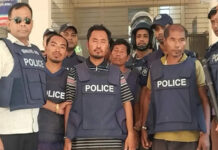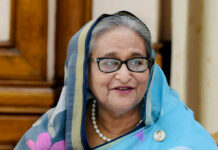Celebrated journalist Bertil Lintner’s new book “Great Game East” is replete with details of the links that once existed between the separatist ULFA and Bangladesh’s military intelligence agency, DGFI.
The United Liberation Front of Asom (ULFA) has been waging an armed campaign for Assam’s independence from India since it was formed in 1979.
The 442-page book by the former correspondent of the Far Eastern Economic Review (FEER) was published by Harper Collins recently.
In chapter 5 titled “Assam and Bangladesh”, Lintner recounts his meeting with ULFA military wing chief Paresh Barua in a DGFI ‘safehouse’ in Dhaka on 29 April 1996.
That is when Barua seemed to have just received the news of an attack on two Indian army colonels outside the Kamakhya temple atop the Nilachal hills in Guwahati – one was killed, the other seriously injured.
“And he (Barua) was not alone when he received the news. He was in a safehouse in Dhaka, flanked by two officers from the DGFI. I was there, too, and it was obvious that Barua’s minders from Bangladesh’s main intelligence agency were not pleased to see a foreign journalist in what was supposed to be a top secret safehouse. Officially, of course, Bangladesh provided no sanctuary to militants from India’s Northeast. That was done only during the days of East Pakistan,” Lintner writes.
He says this meeting was set up by ULFA’s General Secretary Anup Chetia (later arrested, now in jail in Bangladesh, awaiting repatriation to India). Lintner describes the safehouse as a “solid, two-storey concrete building with a basement located in an open field, at the end of a dirt road, and unusually in crowded Dhaka, with no other houses in the immediate vicinity.”
But Lintner says that his attempt to meet the ULFA leaders in Bangladesh 2002 did not work out because of the DGFI.
“In March 2002, I was back in Bangladesh and had made arrangements to meet Sasadhar Choudhury, ULFA’s foreign secretary, in Chittagong. I waited in my hotel, sent him emails through an approved contact. But no one showed up. Later I learnt that the DGFI had warned Choudhury and other ULFA leaders not to meet me… I am convinced that the DGFI, after my visit to the Dhaka safehouse in April 1996, did not want any foreign journalist snooping around the ULFA’s hideouts in Bangladesh,” Lintner writes.
Seven years later, Bangladesh did crackdown on the ULFA and other northeast Indian rebel groups in its territory. Scores of ULFA leaders, including ‘chairman’ Arabinda Rajkhowa, ‘foreign secretary’ Sasadhar Choudhury, ‘finance secretary’ Chitrabon Hazarika and ‘deputy military wing chief’ Raju Baruah were nabbed by Bangladesh security agencies and handed over to Indian authorities.
But Paresh Barua managed to slip past the dragnet and Anup Chetia remains in a Bangladesh prison, having served his term on several charges, awaiting repatriation to India .
Bertil Lintner provides details of the Chittagong arms haul, implicating some Bangladesh intelligence officials with the Dubai-based ARY as being responsible for the illegal shipment.
“Great Game East” mainly focuses on the Sino-Indian rivalry for influence in South and south-east Asia and details how insurgent groups have often been used in these rivalries. This is Lintner’s seventh book in a long chequered career. The rest of his titles mostly focus on Myanmar and south-east Asia but on North Korea as well.
Lintner’s last visit to Bangladesh in 2002 was marked by a detailed expose on the rise of Islamist terror in the country – a piece of journalism that caused much furore and bitter arguments. Titled “Cocoon of Terror” in the Far Eastern Economic Review, that was the first in a series of foreign press reportage on the issue.
The BNP government debunked the piece as “baseless” but Lintner stood by it.
Source: Bd News24










